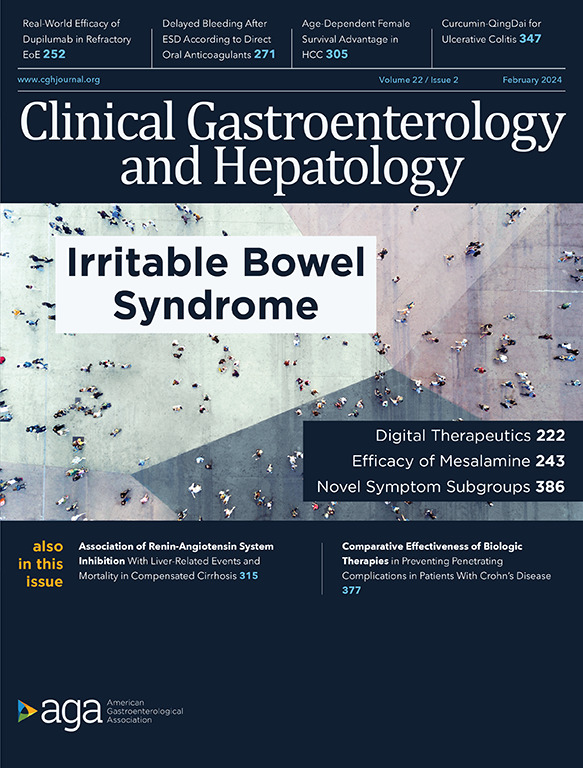接受依曲莫德治疗的溃疡性结肠炎患者的内镜、组织学和综合终点 [106/120 字符,包括空格]。
IF 12
1区 医学
Q1 GASTROENTEROLOGY & HEPATOLOGY
引用次数: 0
摘要
背景与目的:组织学缓解是溃疡性结肠炎(UC)潜在的重要治疗目标,与良好的长期疗效相关。Etrasimod是一种口服、每日一次的选择性1-磷酸鞘磷脂(S1P)1,4,5受体调节剂,用于治疗中度至重度活动性UC。这项ELEVATE UC项目的事后分析根据组织学和复合(组织学/内镜/症状)内点评估了依曲莫德的疗效,并研究了它们的预后价值:中度至重度活动性 UC 患者按 2:1 随机分配到每日一次口服依曲莫德 2 毫克或安慰剂。在第12周(ELEVATE UC 52;ELEVATE UC 12)和第52周(ELEVATE UC 52)评估组织学终点和复合终点,包括疾病清除(内镜/组织学/症状缓解)。逻辑回归分析了基线和第12周组织学/综合终点与第52周结果之间的关联:结果:在第12周和第52周,观察到依曲莫德与安慰剂相比在组织学/综合结果方面有显著改善,包括内镜改善-组织学缓解(EIHR)和疾病清除。接受依拉西莫德治疗的患者在第52周达到临床缓解(CR)的比例在第12周疾病清除的患者中高于未清除的患者(73.9% [17/23] vs 28.3% [71/251])。第12周的组织学改善和内镜改善(EI)与第52周的CR呈中度和高度相关,几率比(OR)(95% 置信区间[CI])分别为2.37(1.27, 4.41)和6.36(3.47, 11.64)。第12周的组织学缓解和EI与第52周的EIHR密切相关,OR(95% CI)分别为3.21(1.70,6.06)和5.47(2.89,10.36):在达到严格的组织学终点和复合终点方面,Etrasimod优于安慰剂;NCT03945188、NCT03996369。本文章由计算机程序翻译,如有差异,请以英文原文为准。

Endoscopic, Histologic, and Composite Endpoints in Patients With Ulcerative Colitis Treated With Etrasimod
Background & Aims
Histologic remission, a potentially important treatment target in ulcerative colitis (UC), is associated with favorable long-term outcomes. Etrasimod is an oral, once-daily, selective sphingosine 1-phosphate (S1P)1,4,5 receptor modulator for the treatment of moderately to severely active UC. This post-hoc analysis of the ELEVATE UC program evaluated the efficacy of etrasimod according to histologic and composite (histologic/endoscopic/symptomatic) endpoints and examined their prognostic value.
Methods
Patients with moderately to severely active UC were randomized 2:1 to once-daily oral etrasimod 2 mg or placebo. Histologic and composite endpoints, including disease clearance (endoscopic/histologic/symptomatic remission), were assessed at Weeks 12 (ELEVATE UC 52; ELEVATE UC 12) and 52 (ELEVATE UC 52). Logistic regressions examined associations between baseline and Week 12 histologic/composite endpoints and Week 52 outcomes.
Results
At Weeks 12 and 52, significant improvements with etrasimod vs placebo were observed in histologic/composite outcomes, including endoscopic improvement-histologic remission and disease clearance. The proportion of patients treated with etrasimod achieving clinical remission at Week 52 was higher among those with disease clearance at Week 12 vs those without disease clearance (73.9% [17/23] vs 28.3% [71/251]). Histologic improvement and endoscopic improvement at Week 12 were moderately and strongly associated with clinical remission at Week 52 (odds ratio [OR], 2.37; 95% confidence interval [CI], 1.27–4.41; and OR, 6.36; 95% CI, 3.47–11.64, respectively). Histologic remission and endoscopic improvement at Week 12 were strongly associated with endoscopic improvement-histologic remission at Week 52 (OR, 3.21; 95% CI, 1.70–6.06 and OR, 5.47; 95% CI, 2.89–10.36, respectively).
Conclusions
Etrasimod was superior to placebo for achievement of stringent histologic and composite endpoints.
ClinicalTrials.gov, Number: NCT03945188; ClinicalTrials.gov, Number: NCT03996369.
求助全文
通过发布文献求助,成功后即可免费获取论文全文。
去求助
来源期刊
CiteScore
16.90
自引率
4.80%
发文量
903
审稿时长
22 days
期刊介绍:
Clinical Gastroenterology and Hepatology (CGH) is dedicated to offering readers a comprehensive exploration of themes in clinical gastroenterology and hepatology. Encompassing diagnostic, endoscopic, interventional, and therapeutic advances, the journal covers areas such as cancer, inflammatory diseases, functional gastrointestinal disorders, nutrition, absorption, and secretion.
As a peer-reviewed publication, CGH features original articles and scholarly reviews, ensuring immediate relevance to the practice of gastroenterology and hepatology. Beyond peer-reviewed content, the journal includes invited key reviews and articles on endoscopy/practice-based technology, health-care policy, and practice management. Multimedia elements, including images, video abstracts, and podcasts, enhance the reader's experience. CGH remains actively engaged with its audience through updates and commentary shared via platforms such as Facebook and Twitter.

 求助内容:
求助内容: 应助结果提醒方式:
应助结果提醒方式:


